|
FAQs on Anemone Identification
36
Related Articles: Anemones,
Bubble
Tip Anemones, LTAs, Cnidarians, Coldwater Anemones, Colored/Dyed Anemones,
Related FAQs: Anemone ID 1, Anemone ID 2, Anemone ID 3, Anemone ID 4, Anemone ID 5, Anemone ID 6, Anemone ID 7,
Anemone ID 8,
Anemone ID 9, Anemone ID 10, Anemone ID 11,
Anemone ID 12,
Anemone ID 13, Anemone ID 14, Anemone ID 15, Anemone ID 16, Anemone ID 17, Anemone ID 18, Anemone ID 19, Anemone ID 20, Anemone ID 21, Anemone ID 22, Anemone ID 23, Anemone ID 24, Anemone ID 25, Anemone ID 26, Anemone ID 27, Anemone ID 28, Anemone ID 29, Anemone
ID 30, Anemone ID 31, Anemone ID 32, Anemone ID 33, Anemone ID 34, Anemone ID 35, Anemone ID 37, Anemone ID 38, Anemone ID 39, Anemone ID 40, Anemone ID 41,
Anemone ID 42,
Anemone ID 43,
Anemone ID 44, Anemone ID 45,
& Cnidarian Identification, Anemones 1,
Anemones 2, Anemones 3, Anemones
4, Anemones 5, Invertebrate Identification, Aiptasia
Identification, Aiptasia ID
2, LTA
Identification, Bubble Tip
Anemones, Caribbean
Anemones, Condylactis, Aiptasia
Anemones, Other Pest
Anemones, Anemones and
Clownfishes, Anemone
Reproduction, Anemone
Lighting, Anemone Feeding,
Anemone Systems,
Anemone
Compatibility, Anemone
Selection, Anemone
Health, Anemone Behavior,
Anemone
Placement,
|
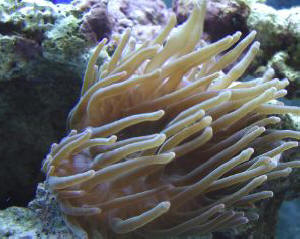
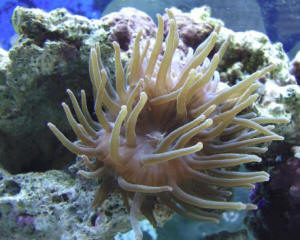
|
 |
New Print and
eBook on Amazon:
Anemone Success
Doing what it takes to keep Anemones healthy long-term
by Robert (Bob) Fenner
|
|
unknown anemone 6/17/10
Hi Wet web media,
We have recently brought some live rock and have some stowaways
of which three are unknown anemones. They are all similar in
appearance and all have hold of the rock, not moving around and
are all feeding on shrimp so we assume (hope) they are happy. We
need help to identify as we cannot find anything that looks the
same on the internet.
<Got me. A "dendritic" species of some sort>
We want to find out as much as possible about them before we put
any fish in, such as size they grow to. They are very small, the
biggest being about 2.5cm across, the foot is purple, tentacles
are browny/purple a few have small green balls on the end and the
mouth in the middle is bright green.
Thanks very much,
Steven
<Try Daphne Fautin's "Hexacorallians of the
World" (.com). Bob Fenner>
|
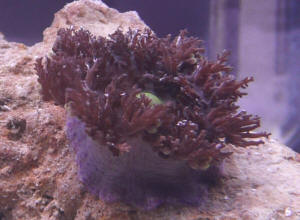 |
|
who killed Toby the goby?
5/30/2010
Hi,
we use your site all the time for researching and identifying our
tank inhabitants -thanks. This is the first time we have written
so please let us know if more info required. We have recently
lost some 'friends', and hoping you can help us not loose
any more. Below are details of our setup, and also some changes
we have made (that we hope haven nothing to do with the
deaths).
Display Tank 4.5'wide x 2'deep x 1.5'back (circ with
Seio 6000Lt/hr, 250WMH 15K, 4' T8 actinic, 5"+ sand bed,
Liverock) ; drains into refugium 3'x1.5'x1.5' (3'
double 20K T5, circ aqua One 2000Lt/hr power head, Liverock);
drains into sump 3'x1.5'1.5' (Live Rock, return pump
PJ MaxFlow 3500lt, protein skimmer reef octopus otp-2000).
Total live rock - aprox 80kg.
Livestock - 9 blue green Chromis, 1 yellow tang, 1 scribbled
angel fish, 1 yellow tailed blue damsel, 1 ocellaris clown, 1
cinnamon clown, 2 large turbo snails, 2 + whelk type snails, 2
large hermits, approx 6 small hermits, heaps of bristle worms, a
few spiny bristle star fish including large spiny black. Should
have peppermint shrimp, but haven't seen them for months.
Several purple tipped bta's,
<Not Heteractis crispa...?>
Corals - devils finger, hammer, Corallimorphs, zoanthids,2 Acan
frags, unidentified fluffy frag, brain, open brain. We have
hitchhiker tunicates, and sponges.
Current tank parameters.
pH 8.2
temp 24-25 degree C
salt 1.024
ammonia 0 (never had an ammonia reading)
nitrate 0 (best we have ever had; usually have trouble getting
under 20)
KH 10.9
Recent Changes:-
3 weeks ago added the refugium. PVC piped, joints allowed to set
(couldn't get clear cement).
<Colored one/s should be fine once cured>
Started moving some bta's into refugium (difficult to
shift).
2 weeks ago - added 5 Chromis, scribbled angel, brown barred
goby.
<Processed how? Quarantined?>
3 or 4 days later - Bi-color Blenny (over 12 months in tank), out
in tank with other fish, looked "happy", full color,
looked 2 hours later, dead, sitting (as per habit, slightly bent)
on rock at bottom of tank.
Checked, no outward signs of disease or injury (other than clean
up crew chewing on tail).
Couple of days later, big hermit seen out of shell, being chewed
on by cleanup crew.
<Mmm>
1 week ago added 30kg of well matured Live Rock, to sump and
refugium.
2 days ago, Brown Barred Goby, found, sitting bottom of tank,
slightly bent, low gill rate, good color, no outward signs of
disease or injury, tried target feeding and water flow, but too
far gone ,dead soon after.
Also found, same day, dead hitchhiker crab, in refugium.
We have done a couple of 60lt water changes over the last month -
water from LFS. Top up every couple of days with RO water.
We have had no deaths in over 12 months, everything seems to be
getting along with each other. Feeding spectrum sinking pellets,
twice daily, some flakes, supplement with frozen shrimp and
Nori.
Seems unlikely coincidence that the Gobioids died so close
together, and the crabs?
<Agreed... but from what?>
Local LFS also stumped.
Do you have any suggestions as to possible causes? We are
devastated to loose our fish, especially ones with
personality.
Thanks for your advice. Adam
--
Adam buzza
<Well... could be a bizarre coincidence, but am leaning more
toward "something" that came in with the new live
rock... but what? Some food organism "that didn't
agree" with the Gobioids? Bob Fenner>
re: who killed Toby the goby? & Anem.
ID 5/30/2010
Thanks Bob for the quick response.
We also though it could be something that was common food to
those animals (we though a toxin in the water would have taken
out more livestock).
<Likely. Yes>
Is there any poisonous algae that we should watch out for?
<Mmm, not really... as in by the time you'd recognize it
as such, it would have debilitated, killed your livestock... best
to avoid such likelihoods by the usual methods of algal
proliferation control... Avoiding nutrient accumulation, using
competitive life forms... Covered on WWM: http://wetwebmedia.com/avoidingalgaeproblesm.htm
and the linked files where you lead yourself. BobF>
Unfortunately we can't blame the liverock, because the Blenny
died a couple days before we put that in.
We had been moving anemones. [here is link of pictures of
anemones for
your viewing only, would love your thoughts on ID.
<This is almost assuredly an Entacmaea quadricolor>
http://picasaweb.google.com.au/EmmaBuzza/Anoneme?authkey=Gv1sRgCOLS2ujP5f6jwQE&feat=directlink
] Ocellaris wont host,
<Happens>
Cinnamon will, they have multiplied in our tank readily, they
only get to dinner plate size, then pup, and sometimes pup
when smaller. We only see the "bubble tip" once in a
blue moon. We originally thought they may have been Ritteri based
on others photo's and the magenta/pink foot, but local Aussie
marine society forums thinks its just a bta. We had to move them
out as they were shadowing and fighting with our corals - hence
new refugium needed to shift anemones off LR.
We did not treat the new fish,
<I would not>
and we did not put the new fish in the refugium (as it was full
of waving, angry anemones), maybe poor judgment call that they
were better off in large tank. They were not purchased from LFS,
they were from an established tank, where we had seen them
very happy, and feeding.
Adam
<Appear healthy to me. B>
|
  |
|
Unknown Anemone 5/19/10
Hi! This is my first time to ask a question here (I've pored
over your site, though), so apologies if I mess up on protocol.
You guys have a great site.
<Thank you Daniel>
First off, I live on a tiny little island on the equator in the
middle of the Pacific; hopefully that helps for the ID. Recently,
I got a Pagurus sp. (pollicaris or some visually similar
species). Hitchhiking on its shell were a group of three anemones
(I think they're anemones).
<Polyp/oid animals of some sort...>
I've attached a pic, I hope it's clear enough and small
enough. These anemones are on the underside of the shell, so does
that mean they don't need much light?
<Likely so>
Could you help ID this for me?
<Mmm... perhaps a Calliactis species... maybe C.
armatus>
Not sure how well you can see it in the pic, but they have
distinct feet and pretty wide bases. Also, could you give me a
brief description of their care needs, like if they can take
small chunks of food, how much light, etc.?
<Are very likely opportunistic feeders on whatever the hermit
is tearing, consuming itself... Not much reliant on
photosynthesis as you speculate>
I've kind of grown attached to them, so even if they are
Aiptasia (my best guess) or some nuisance anemone, I'd keep
them in their own tank. They currently are in a quarantine tank,
just in case.
The end destination for this group is a tank lit for fish/crabs,
not coral, unless the anemones need bright light, in which case
I'll get a new tank and upgrade to the necessary lighting.
However, if these anemones can survive in fish lighting,
they'll be sharing the tank with a red hermit crab. This guy
is the other attached picture. The colors are not exactly true;
the crab is lighter and reddish. Is this crab compatible with the
anemones, or will the crab snack on them?
<Might consume them if very hungry... But likely to actually
move them to new shells with growth, time... they provide
protection against predation>
Thanks much for your lifesaving help,
Dan
<Thank you for sharing. Bob Fenner>
|
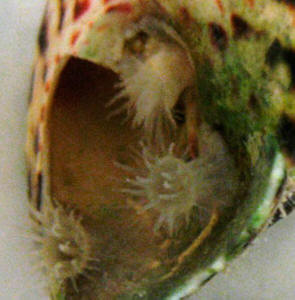 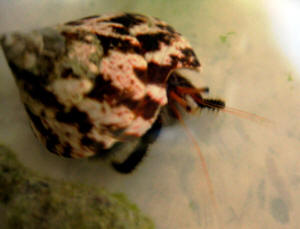 |
|
Anemone ID... dying 5/10/10
Hello all,
<Esteban>
This anemone was sold to me as a Sebae anemone. I am having
doubts as to whether or not that's true. Any help would be
greatly appreciated.
Steve
<Mmm, whatever this is (and it might be Heteractis crispa),
this specimen extremely stressed, badly bleached... Needs TLC...
Stat! Read here: http://wetwebmedia.com/sebaedisfaqs.htm
and the linked files above. Bob Fenner>
|
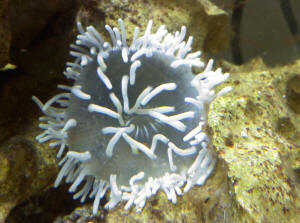 |
|
Curious Pic/Anemone ID 5/6/10
In the center of photo, just above coraline algae..it has a
transparent body with (as you can see) a slight mushroom
appearing top of which many tentacle like protrusions can be
seen. Do you (by my rough description:)) know what this is?
<Appears to be a Glass Anemone of some type, likely the
dreaded Aiptasia.
See here.
http://www.wetwebmedia.com/marine/inverts/cnidaria/anthozoa/aiptasia/aiptasia.htm>
Thx
<You're welcome. James (Salty Dog)>
Mike
|
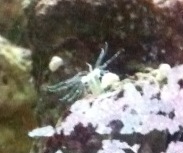 |
|
Anemone ID 4/26/10
Hey guys Ryan here,
<Hello Ryan, James with you today.>
This is a great site! It's very informative and the first
place I go to when I've got questions about anything
saltwater!
<Glad you use/enjoy and thank you.>
You guys helped me out a few times which is great! This is the
first time I'm asking a question though, so I hope I get this
right.
<Shouldn't be a problem. At times we are known as mind
readers.:)>
I've been in the hobby for a year and some weeks now, and
it's fantastic!
I've recently won the battle versus green hair algae and now
feel ready to take on corals and all different kinds of species
of inverts too, as I'm at the FOWLR stage still.
Anyway, I've picked up an anemone from a friend and he
wasn't sure what species it was so I took it as he offered
it. It has duplicated itself in my friends tank many many times.
It's brown by color in daylight, with a cream colored foot.
During the dawn, my daylight (HO T5) switch off and my actinics
remain on. Under the blue spectrum, the anemones look a very
metallic greenish color, and many times they bulb a little bit.
Not like giant balls, but tiny thin bulbs like little footballs,
or iPod headphone plugs (sorry for bad example..
<Good example and is one of the traits of a Bubble Tip
Anemone.>
I had a pair in front of me and thought they looked similar).
I've got an ocellaris clown in the tank and he hasn't
gone near the anemone.
<May be tank bred and usually ignore anemones.>
It was about an inch in diameter when I <please cap
"i's" in future correspondence.> brought it
home, inflated to about 2 inches in size and now is about 2-3
inches in size when fully inflated while the lights are on. In my
friends tank, I asked which one was the original that all the
others were duplicated from, and it honestly was no bigger than
my 2-3 inch size. My question is, could you please help me in
identifying the species?
I've had a look around and visited your huge anemone ID
sections, all of them basically. I've seen some pictures that
looks similar to mine, but in different postings by different
people they were identified differently. Some were identified as
green bubble tips, and others as anemone majano.
I've been searching the web for pictures, and even saw a few
videos on YouTube of anemone majano, and found that I could
possibly have it. Although many did have thin bases, and very
thin tentacles like the common
Aiptasia. I've attached two pictures; one with flow on, and
one without just in case you need to see the mouth.
<Your anemone appears to be a Bubble Tip. May want to
read/learn more here.
http://www.wetwebmedia.com/marine/inverts/cnidaria/anthozoa/bubbletipanemones.htm>
-Thanks a bunch guys keep up the great work!
<You're welcome, and we will certainly try. James (Salty
Dog)>
Ryan
|
  |
|
|

